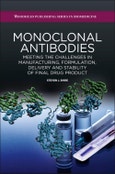Monoclonal antibodies (mAbs) are naturally occurring complex biomolecules. New engineering methods have turned mAbs into a leading therapeutic modality for addressing immunotherapeutic challenges and led to the rise of mAbs as the dominant class of protein therapeutics. mAbs have already demonstrated a great potential in developing safe and reliable treatments for complex diseases and creating more affordable healthcare alternatives. Developing mAbs into well-characterized antibody therapeutics that meet regulatory expectations, however, is extremely challenging. Obstacles to overcome include the determination and development of physiochemical characteristics such as aggregation, fragmentation, charge variants, identity, carbohydrate structure, and higher-order structure (HOS).
This book dives deep into mAbs structure and the array of physiochemical testing and characterization methods that need to be developed and validated to establish a mAb as a therapeutic molecule. The main focus of this book is on physiochemical aspects, including the importance of establishing quality attributes such as glycosylation, primary sequence, purity, and HOS and elucidating the structure of new antibody formats by mass spectrometry. Each of the aforementioned quality attributes has been discussed in detail; this will help scientists in researching and developing biopharmaceuticals and biosimilars to find practical solutions to physicochemical testing and characterization.
Please Note: This is an On Demand product, delivery may take up to 11 working days after payment has been received.
Table of Contents
1. Overview of Monoclonal Antibodies2. Physicochemical Characterisation of Monoclonal Antibodies
3. Glycosylation Analysis
4. The Use and Application of LC-MS-MS Petide Mapping Methodology for Primary Structure Confirmation, Sequence Variant Analysis and Comprehensive Analysis of Post-Translational Modifications
5. Separation Techniques for Characterization and Quantification of Antibody Purity
6. Higher Order Structure and Free Thiol
7. Advanced Structural Elucidation of New Antibody Formats by Mass Spectrometry








